Revisiting 2004 Bordeaux, 10 Years On
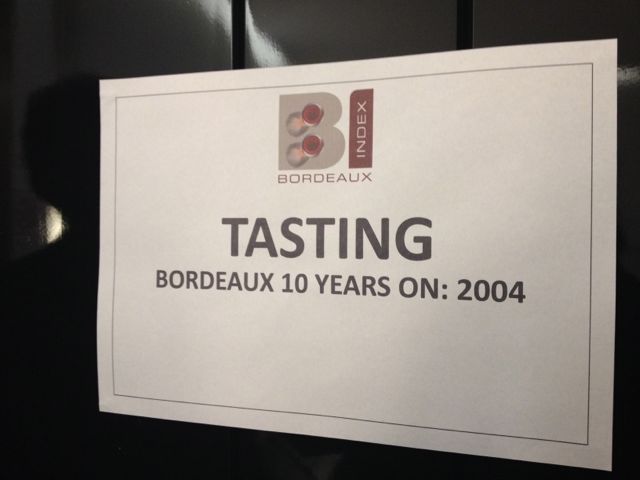
By Panos Kakaviatos for Wine Chronicles
As Wine Chronicles gets underway, this is a fitting tasting because Bordeaux 2004 was the first Bordeaux vintage I had tasted fully from barrel. So it was great to assess many of these wines again 10 years later.
So much the better to base one’s judgment on an excellent tasting organized by Bordeaux Index in London.
Many thanks go to Michael Schuster for organizing the event and to his wife Monika for splendid quiche and other delectable foods and 2004 Dom Perignon for a post-tasting lunch.
All wines tasted were red.
Well-known tasters, including Wine Advocate Neal Martin, attended this event, which was held under impeccable conditions. I was surprised that more people did not attend, as there was plenty of room to stand up and ponder the wines if one so desired. Seating areas were spacious with much room for the spitting bucket, a laptop and more than one glass if one wanted to compare – as I did. Even the weather outside was sunny and pleasant: conducive atmospherically for tasting wine.
Regarding the wines tasted – over 60 of them, ranging from Ausone and Petrus to more humble cru bourgeois – there were no big surprises. Some of the wines (but thankfully not most) seemed a bit over-extracted or with the oak dominating the fruit. Others proved rather boring. But many tasted quite delicious, with fine freshness and lingering finishes. 2004 is a “classic vintage” in the sense that it was not particularly great, but also nothing went wrong, either, such as in 2013.
So you get Merlot-based Right Bank wines that 10 years on are more open for business than the often more closed Left Bankers, particularly in the Medoc. Tasting 60+ wines from 11 am to 4 pm in one day was arduous. Fellow taster Adam Lechmere – check out his 2004 notes on his blog “Rot” – and I were rather tired after we finished. It takes concentration, and, towards the end, one succumbs to palate fatigue. Ideally, I would have preferred to revisit some of the wines, especially the first growths and other highly rated Bordeaux, with more time in glass, but time just ran out…
We were asked to name our top five wines and top five values and I do not exactly remember, as I handed in my sheet without copying down what I wrote. But, from memory, Petrus, Lafite and Latour, Haut Brion and Margaux and Ausone are candidates for any top five wines of 2004.
For top five values, it was rather difficult too choose, but Rauzan Segla was singing (and was not too expensive en primeur), as were an excellent Domaine de Chevalier from Pessac Leognan, Canon from Saint Emilion and Gloria from Saint Julien – hardly expensive and pure fun. And Grand Puy Lacoste, no doubt.
SAINT EMILION
Château Ausone: Very deep, rich and nuanced. A rather amazing wine indeed. Sumptuous and very long, but also imposing. I would think that the wine needs at least 10 years to approach its drinking window but – my, my – this was special. 96
Château Cheval Blanc: This exuded charm and conveys Cabernet Franc freshness. I recall really liking it en primeur. Tasted side-by-side with Ausone, I prefer the latter at this stage. I enjoy Cheval Blanc’s expected mentholated freshness, but I feel that its delivery comes across as slightly ho-hum for a terroir of this caliber (not to mention the price). Perhaps it is closed down and for this reason, I give it the benefit of the doubt. 92?
Château Grandes Murailles: Somewhat evolved organic notes. Clean. Fresh attack. Mid palate is medium bodied. A touch of heat on the finish. Some blackberry and plum on the finish. Overall a charming wine and ready to drink. 88
Château Pavie Macquin: Nose has an almost Schnapps like feel, as does the palate. With a deeper hue, the wine is less transparent, with a heavier and more New World aspect and more weight on the palate. The alcohol is present as is some heat. I feel my gums just slightly assaulted but can understand why some tasters would love this. 14% alcohol felt. 88-91, depending on your taste
Château Larcis Ducasse: Although fellow taster Adam Lechmere found this short on the finish, I liked its more nuanced earthiness, coming after the Pavie Macquin. And it seems more interesting than Grandes Murailles, with a nuanced mix of fruit and (just a touch of) truffle. Very pleasing warmth on the palate – non aggressive. Smooth texture and to me at least a more lingering finish, with better integrated 14% alcohol. 92
Château Canon La Gaffeliere: Looks more evolved than preceding wine. Warmer profile, riper fruit – rather like stewed cherry but a pleasing palate. There is acidity that balances the wine, and it is pleasing – I recall enjoying this bottle last year. But it does not have as much freshness and lift as the Larcis. 91
Château Magdaleine: Somewhat closed nose. A touch of light red fruit, delicate. The nose is not very expressive. But the palate has delicate touches of fruit, if giving off an overall inconsequential impression. Disappointing for a premier grand cru classé. 86
Château Troplong Mondot: Noticeably darker hue. More expressive than the above with some mid-palate juice but the oak derivation seems to dominate with a drying aspect on the finish. I sold some of my 2004s and probably did so wisely. 87
Château Clos Fourtet: Bright nose here, red fruit. 13.5% alcohol, like Canon. Brisk attack and fine mid palate presence, fruit driven, nicely balanced richness and energy. Not a large scaled vintage, but a very successful expression of the 2004 so I say “bravo”! 93
Château Canon: Slightly darker hue. Violet, and fruit. An intriguing nose. The palate is fuller bodied and yet also suave. Somewhat hard on finish but this could mean that tannins just need time to resolve. Not sure. Promising opening and mid palate. 92
Château Figeac: Lovely aromatics, spicy and complex. The palate evokes freshness indeed, much more than Magdelaine for example. Perhaps a touch short on the finish. Going back to the Figeac – after tasting the Angelus – one can appreciate both styles in 2004. 91+
Château Angelus: Talk about a different style here. Darker and denser. Nose is actually rather contained. There is lots of richness on the mid palate that is not as drying as, say, Pavie Macquin. Rather closed in at this stage. But promising! Packed with flavor and a reminder that Angelus is a consistently well-made wine. Whether it deserved its promotion to A level PGCC and corresponding absurd pricing is another matter… 92+
POMEROL
Petrus: Wow what depth and sneaky persistence. While Ausone impresses you with volume and opulence, this is more subtle. Now I realize why this wine is so prized. What depth and richness that is so not obvious. Esteemed wine advocate Neal Martin found it somewhat light and preferred the Lafleur, but I really liked this Petrus as it seemed juicier as compared to the Lafleur. 95
Château Lafleur: There is a very muscular and even tough aspect to this wine, but also amazing depth and richness on the mid palate through to a spicy and long finish. Still, I feel that it needs time to resolve in the bottle. Compared to Petrus, it is not as graceful. 94
Château Gazin:Sweet plum and cherry nose. Palate is straightforward and pure. Mid palate is high toned – mark of the vintage. Yet a lovely wine! Lingering finish. 91
Château Nenin: Less focused here than the Gazin. A bit soupy on the mid palate but not displeasing. Still, merely OK. 88
Château Clinet: Rather light hue, transparent ruby. Red fruit aromas, but also somewhat stripped on the nose. Oak derivation and fruit. Palate is also warm but rich and pleasingly smooth if lacking some nuance. Not sure about this one. 89
Château Eglise Clinet: Deeper hue, violet, floral aromatics. Rich and full on but with elegant energy. Closed in, like the Angelus, but here we have very nuanced spices and flavors that appeal. Balance if just a tad warm. But not aggressive. Lovely and 13.5% alcohol well integrated. 91+
Château Clos l’Eglise: Robust nose but too much oak derivation! Very rich and appealing with oaky spice, if you like that style. But somewhat drying on the finish, and 14% alcohol. What gives? 88+
Château La Conseillante: Dew and violets. Smooth texture and excellent verve. This is far better, makes Clos ‘Eglise look monolithic! 93
Château La Fleur Petrus: Soft expression here, almost too polite? There is pleasing freshness but it borders on the Magdelaine like facelessness. The palate is smooth enough, and nuanced. But do rising prices for this wine merit this vintage? Upon subsequent tasting, actually not that bad… more floral and elegant but still rather underwhelming. 90
Château Trotanoy: Cool blueberry fruit, with light expressions of iron, creosote. The palate is nuanced and rich yet subtle, in its burgeoning flavors. Give this time, it should develop nicely, although it lacks the oomph of, say, the 1995. Nice finish, marked by freshness. 92+
PESSAC-LEOGNAN
Château La Mission Haut Brion: Very meaty, iron rich style. Very long on the finish – with a traditional, non-glossy feel. Very good. Interesting that both this and Haut Brion were only 13% alcohol in 2004. Nice job! 93
Château Haut Brion: More nuanced and complex – I feel that the Haut Brion is clearly more interesting that the Mission, which is almost four square by comparison. Very long finish, with fine tannins that will need at least 15 years to fully melt and reach an optimal drinking window. 95
Château Malartic Lagraviere: Robust red pepper grilled on the nose. Broad on the palate, rich yet not heavy or too modern. A bit glossy through to the finish however. This will please people, if not make intellectuals very happy. 90
Château Smith Haut Lafitte: A slightly extracted nose with oak derivation yet pleasingly chocolate like. The palate conveys rich fruit however, with an upfront style that is flavorful and rich without being drying or oak derived, so a curious situation where the nose does not really match the palate, which displays fine mid palate sap. Give it time. This could get interesting. 91
Domaine de Chevalier: Herbal aromatics that come across fresh and more natural than both of the two preceding wines. Rich and flavorful, and here we have a purity that is very pleasing. Lovely freshness on the finish. Bravo! 93
Château Haut Bailly: Interesting that all of the above had about 13% alcohol, and this one has 12.5% on the label. Organic aromatics display some evolution. Red fruit mixed with fresh forest floor, after rainfall. The palate is marked by verve and lift, with red fruit, again. A close race with Domaine de Chevalier, but here we have the most lift. Haut Bailly seems to end with the most iodine-like energy. Lovely! I tasted this again with SHL and the difference is clear. There is more crispiness to the Haut Bailly. I prefer it. When I tasted Haut Bailly and Haut Brion side by side, the similarities outweighed the differences. The Haut Brion was deeper and more opulent and – in the end – longer. But both wines shared fine breeding, characterized by freshness! 93+
MARGAUX
Château Du Tertre: Lovely light fruit on the nose. 13% alcohol as with Giscours. Smooth delivery. Cohesive. Lingering finish, marked by some spice. Clean, Lovely wine. 91+
Château Giscours: Floral aromatics but a bit closed in. The palate is ripe enough with some herbal as well as red fruit characteristics. Slight heat on finish. I prefer Du Tertre as a riper and more solid palate, but Giscours may need some time. 90
Château Malescot St Exupery: Spicy rich and somewhat glossy. There is a certain monolithic character to this wine that annoys. 87
Château Brane Cantenac: Fresher and more red fruit but a bit edgy… A bit under-ripe? I do get a bit of herbal/vegetal. Not sure. But it has more freshness than the Malescot to which it was compared. 88+
Château Lascombes: Oak derivation but not too oak plank like. There is a juiciness from the vintage that is pleasing. Fairly straightforward pleasure. 89
Château Rauzan Segla: More gravitas here. Much more substance: a veritable 2nd growth. Spiciness, red and black fruit. Cassis. Not ready but there is freshness and substance and this will enter its drinking window in about 5-10 years… And yet, going back to this, as compared to Palmer, it has elegance and nuance while the Palmer gives off a more muscular feel. Château Margaux is clearly superior with greater breadth and dimension while remaining very elegant. 93
Château Palmer: Another dimension here, broader and richer yet retains a certain classicism. What a lovely wine! Still rather primary! I would bet that this bottle needs easily about 10 years to start its proper drinking window. But Château Margaux outduels this superb wine with its superior finesse! 93+
Pavillion Rouge de Margaux: Very pure and crisp. Just as good as Rauzan? A touch of heat, very faint, detracts a bit. Going back to Rauzan, one does get greater depth and opulence overall from Rauzan Segla. But there is pleasure here. Certainly a high price – as it is the second wine of a first growth – but the quality is there. 92
Château Margaux: A very supple attack accompanied by perfumed floral aromas, with a touch of dew and herbs. The texture is silky with rather soft tannins and a touch of spice on the mid palate that is enveloped by layers of flavor in a subtle manner. There is underlying grip and a layered aspect to the finish, long and lifting. Quite an impressive showing! 94+
SAINT JULIEN
Château Branaire Ducru: Fluid and smooth if not having that much consequence – of course I had just tasted Palmer and Rauzan and Margaux just before. So, let’s take a deep breath and taste again. Cranberry and strawberry aromatics. Very smooth palate, but not glossy modern. A delivery that will please you. With some subtle creeping earth tones. Nice! 90+
Château Beychevelle: Fruit driven. Elegant. Perhaps slightly angular compared to the Branaire – I like tasting these side by side as the estates face each other! Give this more time to come together and I am sure that it will be pretty nice in about 5-10 years. Both are about 13% alcohol. 89
Château Gloria: Frank and fresh and … delicious! This has lovely medium-bodied expressions of red fruit, ripe and delicious. Not yet tertiary. Perhaps the tannis are a tad hard, but give it time to resolve. I would buy this! Other tasters voted Gloria, too, as one of the top five “value wines” of the tasting. 92!
Clos du Marquis: In comparison, this second wine is good but not as fun. Somewhat harder overall albeit with dark fruit on the nose and palate, and a peaking flavor intensity on finish, a more marked finish – but also a bit angular: not as smooth as Gloria! 89
Château Talbot: Hint of vegetal on the nose. The palate is however fresh and pleasing. I am now thinking of steak. But too bad that it lacks ripeness… And it has a bit of a prickly finish. 87
Château Gruaud Larose: A superior nose. Meatier and juicier on the palate. My. This is pretty darn good and substantial yet high toned, fresh. Very nice job even if it lacks the concentration of a great vintage. I do not understand why Robert Parker did not like it. It has verve. 91+
Château Leoville Barton: Expressive and straightforward, a bit like Gloria. Smooth and refined. A bit more gravitas. Fresh and tasty not yet tertiary. Delicious and the most approachable. 92
Château Leoville Poyferre: The nose is not as expressive and the palate is a touch more aggressive, a touch more extracted but I can see why some tasters would prefer this style. Very well made wine but just a bit hard – give it time, I hope. Although there is a bit of heat on the finish. 91
Château Leoville Las Cases: The most depth of the three Leovilles: certainly shows layers of flavor. Intensity that neither Barton nor Poyferre match. Wow, this has some serious gravitas! And freshness. My preference among the three. 93
PAUILLAC
Château Mouton Rothschild: This has the Prince Charles sketch label, and I own three bottles. Smooth and delicious, displaying dark red fruits on the nose and palate as well as espresso and chocolate, ending on a lifting cedar finish. I could sense the Pauillac grip but well enveloped. It does not have the power of Latour or the elegance of Lafite, however. 94
Château Lafite Rothschild: More “breeding” here, with greater finesse and density all at once. Wow! I think Lafite actually beats Latour in 2004 as it manages to combine the finesse of Margaux with the power of Latour. 96
Château Latour: Lots of weight to this wine. Intense. Perhaps the longest finish among the three first growths, marked by more raw power. Wow. Certainly among my favorites. 95
Château Haut Batailley: Spicy and subtle and … soft. Hugh Johnson has written long ago that this estate is more Saint Julien than Pauillac and 2004 is clearly the case. A lovely drink, just entering adolescence and can be enjoyed with steak today but will be better in 5 years. 90
Château Grand Puy Lacoste: Now, I am tasting this five years after a tasting I had organized with a German merchant for an article that appeared in Decanter magazine comparing the 5th growths of Pauillac. Pure and smooth and delicious! And more oomph than the Haut Batailley. Going back to GPL, however after tasting Lynch Bages, and it seems a bit “aquatic” by comparison, but not without substance: this too, needs time! 91+
Château Lynch Bages: Greater density here. Without being modern or hot. Quite a serious wine! Give it another 10 years. I like how this is going even if the tannins seem a bit austere on the finish at this stage, because the substantial mid palate reassures. Juicy mid palate, cassis, dark fruit. Wow! I really get the “Poor Man’s Mouton comparison with this vintage although – going back and re-tasting Mouton – the Mouton has far more substance on the palate! 92+
Château d’Armaillac: Like a delicious pasta dish, this is savory! Rich and flavorful. Perhaps not as deep or as complex as some of the other wines but delicious. And counter intuitive, when one thinks of 2004. Perhaps the Merlot helped. 90
Château Clerc Milon: The nose is not as savory as the above wine. But the palate shows more depth and texture. Give this a bit more time – 5 years – and it will likely outpace the preceding wine. 91
Château Pichon Longueville Comtesse de Lalande: Herbal charm. Richness and spicy flavors! Needs time. I am glad to own a few bottles of this vintage. Can be enjoyed now, but tannins need about 5 years to resolve. 93
Château Pichon Longueville Baron: Beef blood but really clean blood. Like at a butchers. The palate is clean and streamlined without being glossy! A great showing. Not as seductive as the Comtesse but more muscular in a very smooth manner. Excellent depth! I like! 93
Château Pontet Canet: This has “disjointed power” for now. I like the tannic edge but it is not as cohesive as either of the above. Mid palate richness but the finish is a tad jagged. 91
Petit Mouton: Meaty aspect. Straightforward and rich. Slightly austere finish. 90
Forts de Latour: More substantial palate here. More serious second wine. Very weighty. Reminds me a bit of LLC. Quite a nice job indeed. 92+
SAINT ESTEPHE
Château Montrose: This has a chewy tannin aspect with meat and just-starting tertiary aspects. Smooth and supple in fact. I was expecting more austerity but instead felt invited to eat some kind of pot roast. Rich mid palate, and smooth finish. More open than I thought it would be. How much Merlot is here? 92
Château Cos d’Estournel: A bit more “made up” on the nose and palate. It just smells a bit more New World like to me. Yet the mid palate has plenty of chutzpah – more so than Montrose. What bugs me is the slightly drying finish. Montrose, juicier, does not have that! 91
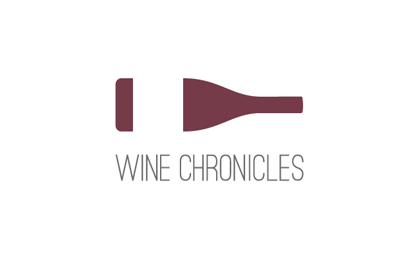 Wine Chronicles
Wine Chronicles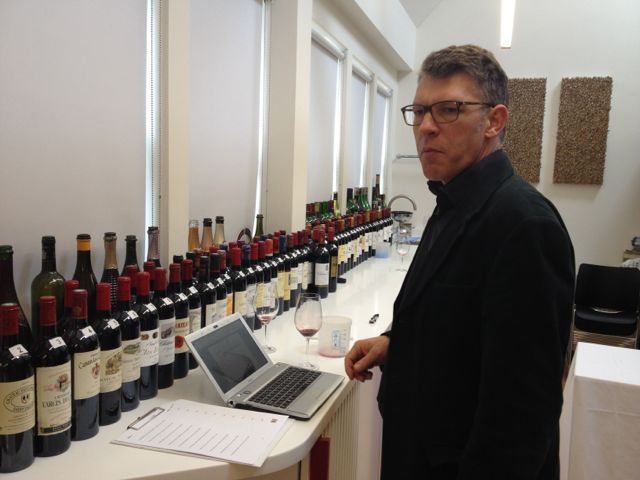
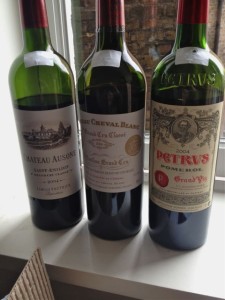
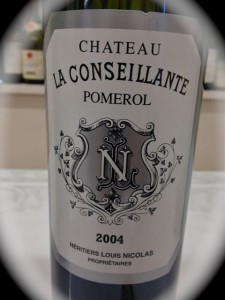
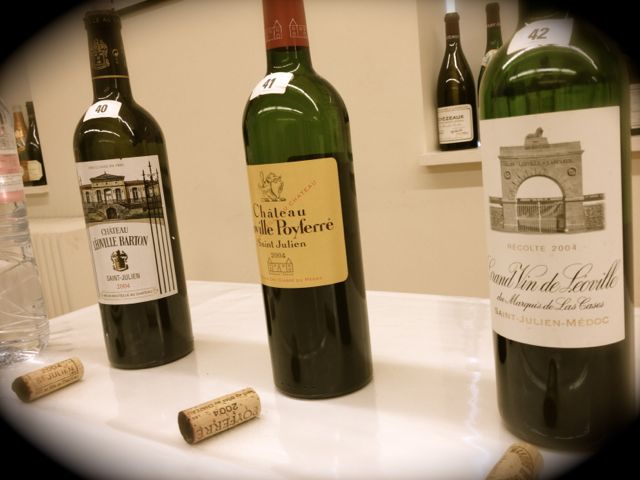
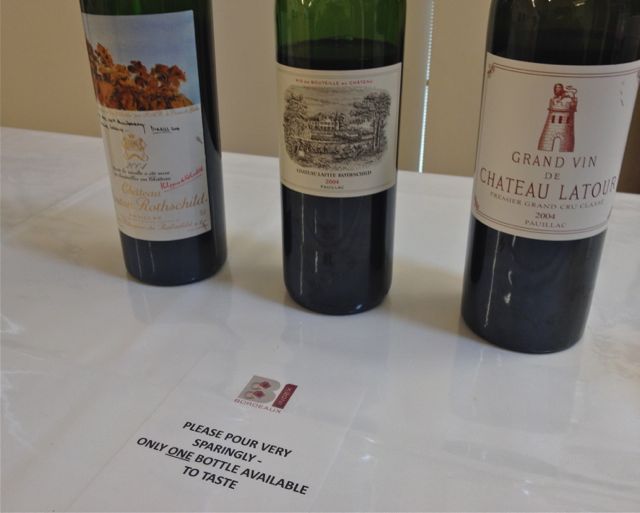

Guess you tried the 2004s 10 yrs too early 😉 nice to hear some good tendencies in the 2004 perspectives. Not wondering about the superiority of Chateau Margaux… Indeed there is no hurry in approaching this underwhelmed vintage.
Cheers Nubian